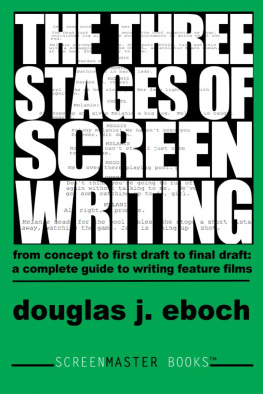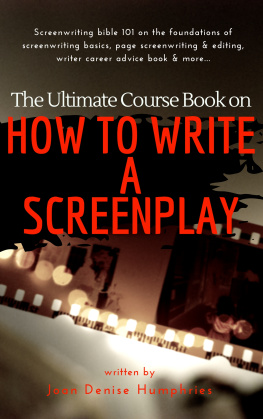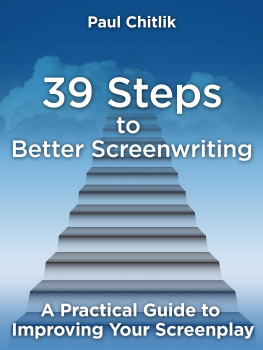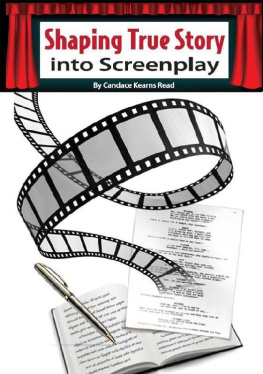THE THREE STAGES OFSCREENWRITING
By
Douglas J. Eboch

Copyright 2015 by Douglas Eboch.
All rights reserved.
Published by ScreenMaster Books at Smashwords
This ebook is licensed for your personalenjoyment only. This ebook may not be re-sold or given away toother people. If you would like to share this book with anotherperson, please purchase an additional copy for each recipient. Ifyoure reading this book and did not purchase it, or it was notpurchased for your use only, then please return to your favoriteebook retailer and purchase your own copy. Thank you for respectingthe hard work of this author.
Limit of Liability/Disclaimer of Warranty:While the author has used his best efforts in preparing this book,he makes no representations or warranties with respect to theaccuracy or completeness of the contents of this book andspecifically disclaims any implied warranties for a particularpurpose. No warranty may be created or extended by salesrepresentatives or written sales materials. The advice andstrategies contained herein may not be suitable for your situation.The author shall not be liable for any loss of profit or any othercommercial damages, including but not limited to special,incidental, consequential, or other damages.
This book is available in print at mostonline retailers.
For more information or permissions, pleasecontact:
ScreenMaster Books
5737 Kanan Road, Suite 114
Agoura Hills, CA 9130
Also From ScreenMaster Books:
The Hollywood PitchingBible
A Practical Guide to Pitching Moviesand Television
By Ken Aguado and Douglas J.Eboch
Finally, a book that tells the truth aboutthe art of pitching in Hollywood. In clear language, suitable forthe beginner or the seasoned Hollywood professional this bookbreaks it down, step by step. From choosing the right idea, toselling it in the room, this book tells you how it's done. Withdecades of combined experience working in Hollywood as buyers,sellers and teachers, the authors have created the definitive bookthat will demystify the pitching process. It shows a reasoned,logical point of view and is supported by numerous specificexamples. If you want to work in the Hollywood creative community,you must know how to pitch. This book will show you how.
Bible is the right word.This is the Truth about pitching. Just do what it says.
- Gary Goldman (Writer/Producer, "Total Recall,""Minority Report," "Big Trouble in Little China")
ScreenMasterBooks
Table ofContents
Acknowledgements
Many people helped me with this book. Firstand foremost I must acknowledge those who read early drafts andgave me feedback: Cindy Davis, Paul Guay, Ken Aguado, Pavan Ojha,Bill Gladstone, Lisa Kors, Robert Watson, and Kat Smith. Theiradvice greatly improved this book. I also owe a great debt ofgratitude to all of the teachers, mentors, producers, agents,managers, and fellow screenwriters who taught me how to write. Inparticular, I want to single out teachers Frank Daniel and DavidHoward. I also am eternally grateful for Emily Dephoure, Aghi Koh,Eric Kim, and Stokely Chaffin, each of whom gave me a criticalbreak on my path to a screenwriting career. Finally, thank you tomy Mom and Dad who always encouraged me to pursue my dreams.
Introduction
Why another book on screenwriting?
Fair question. There are a lot of them outthere. Let me tell you why I went to the trouble of writing thisand maybe that will help explain why I think the world needsanother screenwriting book.
I became a screenwriter because of StarWars and Time magazine. After I saw Star Wars asa kid, I became obsessed with it, reading everything I could aboutthe movie. At that time, there wasnt much information availableabout how movies were made. No DVD commentaries, movie magazines,or movie websites for a kid to seek out. But my dads Timemagazine had an article about Star Wars, so I read it. Andthats where I learned about a guy named George Lucas who was adirector. Sounds like a fun job, I thought. Thats what Imgoing to be when I grow up.
Not such an easy thing when you go to highschool in Juneau, Alaska and dont know anybody in the filmbusiness. I went to the University of Southern California filmschool because I learned thats where George Lucas went and myguidance counselor didnt even know you could major in film.
I started out focusing mostly oncinematography, and when I graduated I worked small jobs as aproduction assistant, gaffer, or grip. On the side, I was workingon screenplays. I discovered I had more of a passion for thewriting part of making movies than anything else. So I went back tograd school, majoring in screenwriting. And over time I discoveredwriting was the thing people were most willing to pay me to do.
I learned story structure (of the three-actvariety) in grad school back at USC. Ive also read dozens of bookson the subject, most of which added to or altered my approach insome ways. More importantly, Ive written over twenty-fivescreenplays, some of which were bad, some of which were good, someof which got me an agent or writing work, and in one case (so far)got made into a big hit movie Sweet Home Alabama. Ivealso written a childrens play thats been performed thousands oftimes (Sleepover at the Stable), a video game (NightmareCove), and an animated television pilot (The MOFFShoppe). Each experience helped me hone my approach toscreenwriting.
Then, I got hired to teach a screenwritingclass at Art Center College of Design. I naturally built mysyllabus around what I was initially taught. But I quickly realizedsome of that stuff I never actually used. Plus, I wanted to includethe many other things that I had learned since. So I adjusted theclass to reflect my real world experience. I also asked otherprofessional screenwriters what they thought about varioustechniques and adjusted my teaching process further.
Since then I have had the experience ofhelping hundreds of students hone their own screenplays. Ive seenthe mistakes they commonly make and I continued adjusting myteaching approach to head off those mistakes. Ive also become abetter writer myself in the process.
I was looking for a book to use as a textbookfor my class. I found some very good screenwriting books, butnothing that was both comprehensive and deep on all the subjects Icovered. Many gave a useful account of structure; far fewer dealtwith crafting a powerful scene. Almost none covered techniques forrewriting. And there was a lot of misinformation about characterdevelopment out there.
So I wrote this book to provide a completeguide to the craft of writing a screenplay the way theprofessionals do it. I will cover each part of the processin-depth; giving you the theories, techniques, and tools I havefound to be the most practical in my own writing career.
And I will endeavor to always keep the focuson creating a screenplay that can actually be turned into a movie.Because thats the goal, isnt it.
How to Use This Book
The screenwriting process consists of threedistinct stages that require different mindsets. As youveundoubtedly figured out from my title, Ive divided the book bythose three stages.
The first stage is story development. This iswhere you figure out what your story is, who the characters are,and what happens. It requires both creativity and an understandingof narrative structure.
The second stage is writing the first draft.This is where you take the solid skeleton you built in the firststage and flesh it out with action, dialogue, spectacle and all thethings we love in movies.
Next page







![Watt - The 90-day screenplay : [from concept to polish]](/uploads/posts/book/103527/thumbs/watt-the-90-day-screenplay-from-concept-to.jpg)
